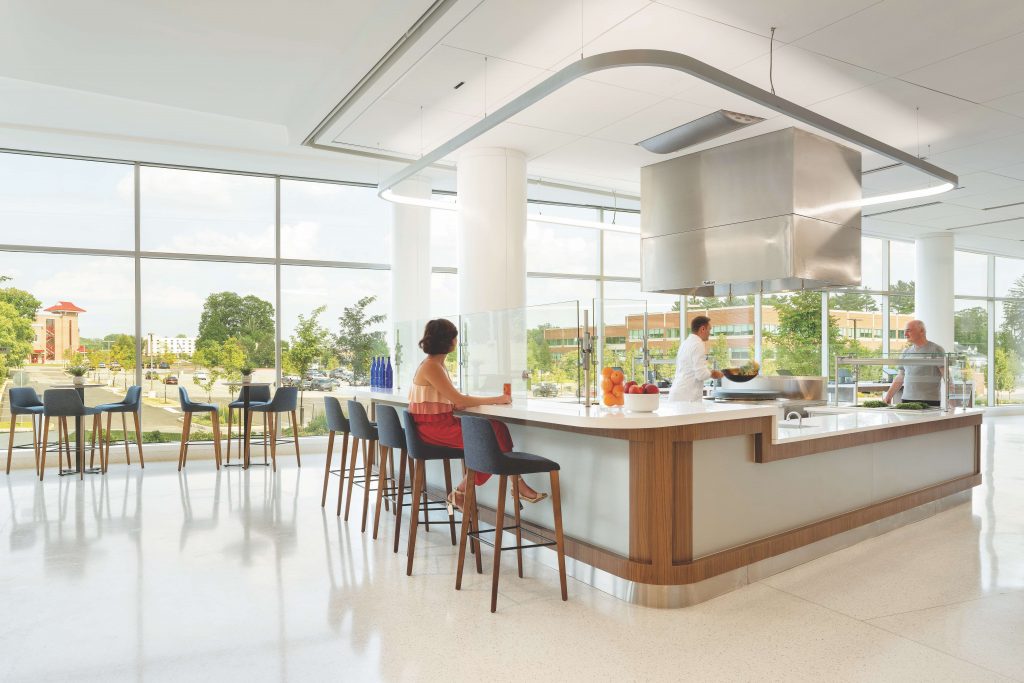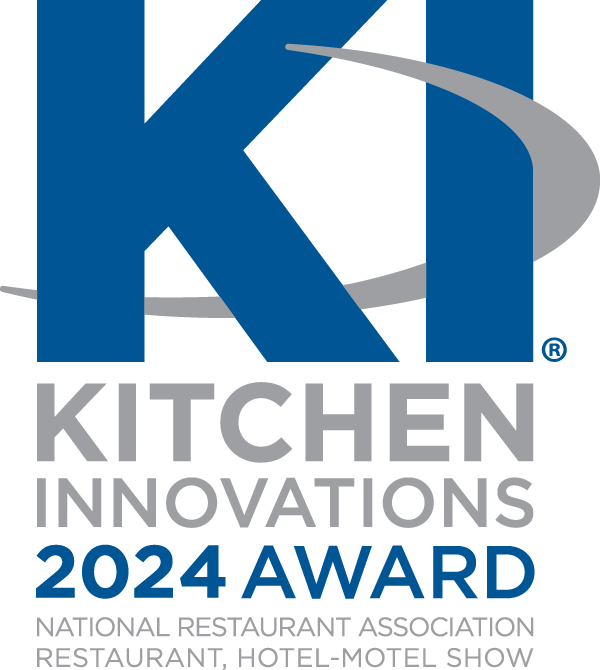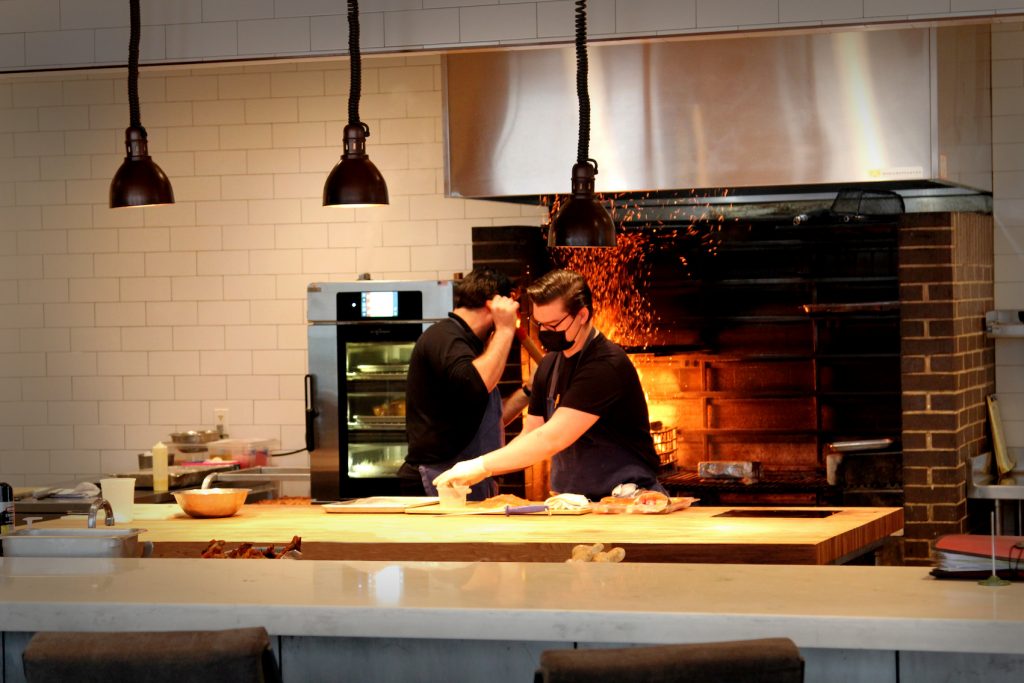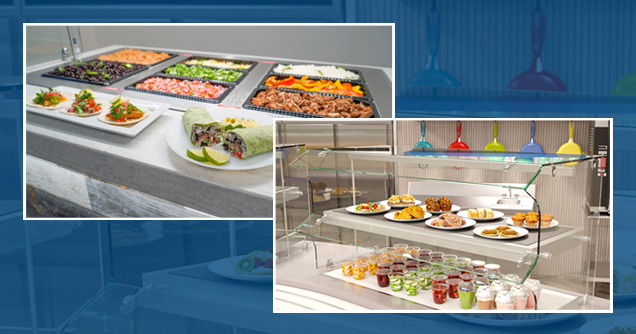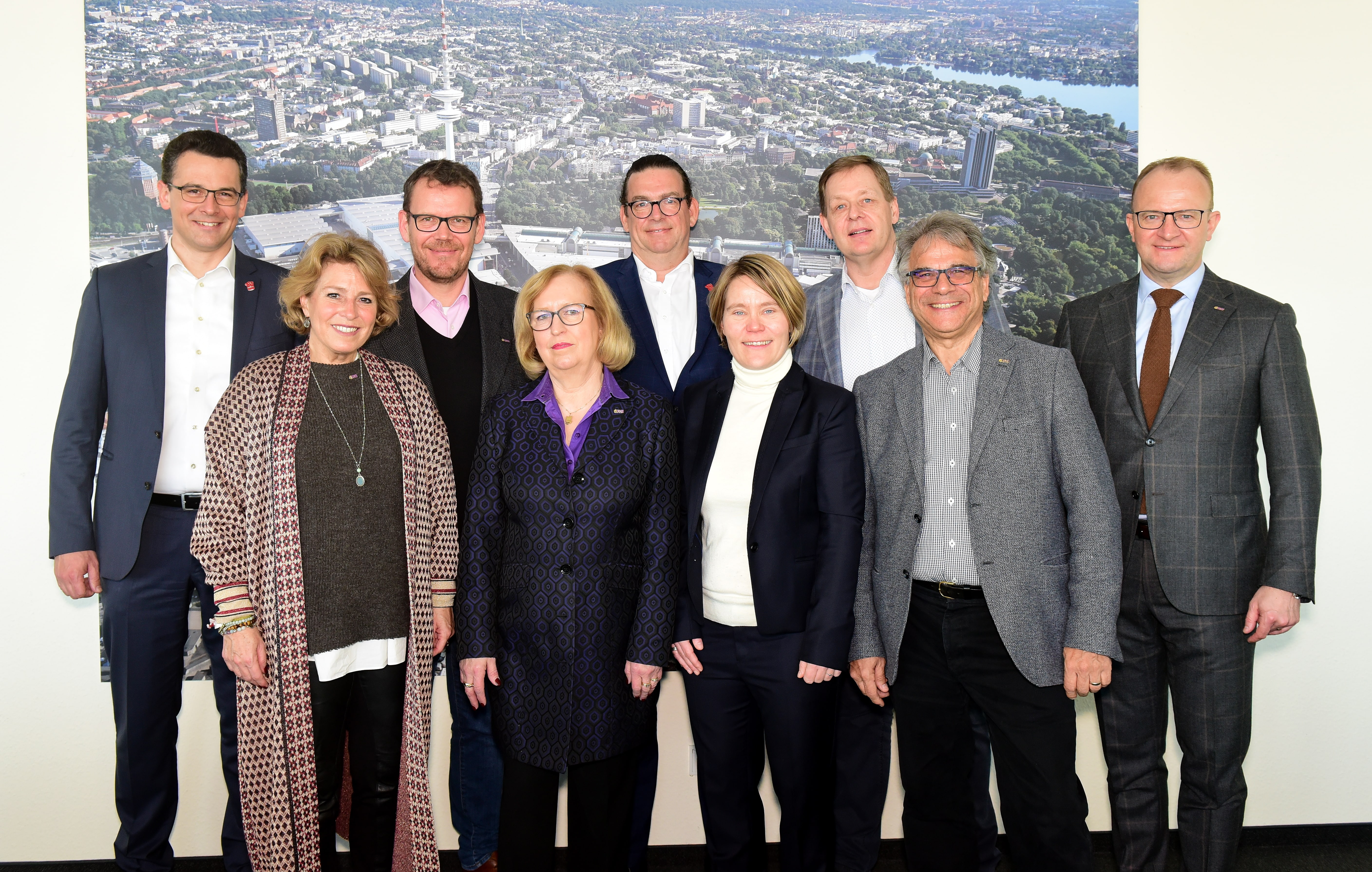
Attendees:
Tina Nielsen (TN), Foodservice Consultant (chair)
Roberto Assi FCSI (RA), Prima Consulting
Hildegard Dorn-Petersen FCSI (HDP), Hotel Consulting
Alexander Hofer FCSI (AH), H44.Team
Bettina von Massenbach FCSI (BM), Oyster Hospitality Management
Thomas Mertens FCSI (TH), S.A:M Strategy Consulting
Helge Pahlke FCSI (HP), K-Drei
Mark Joseph Müller, managing director, Eloma
Florian Sell, senior international account manager, Eloma
Tina Nielsen (TN) What do you see as the main challenges that are impacting on the way operators are managing and designing commercial kitchens?
Helge Pahlke (HP) One is the cost of building. Therefore, kitchens will be smaller. We design the staff canteens for German Rail. There used to be a massive kitchen and we’re starting to reduce it to 30%. That means we have 70% in the front of the house. We see the same happening with hotel kitchens. The biggest part – and the money – will be in the front and not in the back.
Bettina von Massenbach (BM) Opening up the kitchens is building up trust for the customers, because you see what you’re getting and how it’s produced.
Hildegard Dorn-Petersen (HDP) A priority for my clients is freshness, this is very important for wellness and spa resorts. However, there’s a shortage of kitchen staff, so they have to find a way of providing freshness and regional food in a cost-efficient way.
Alexander Hofer (AH) In this industry, everybody is talking about how we are missing employees, but we talk too much about the problem and not enough about the solution. I work in small hotels with no more than 100 rooms. When you charge €500-700 for a room, you need employees who are highly qualified and in this sector, the jobs are sexier and that’s the point. We need to make these jobs more attractive.
In our province, which is the north of Italy, the local government invests a lot in the gastronomy schools yet they still have problems because, although the schools are very good, just 30% to 40% of the students remain in the hospitality sector.
We have to work together to make it sexier to do those jobs because food is always about passion and about taste. Even if it’s just a sandwich, we want to have a good sandwich. And storytelling has to be authentic and not just a nice story. The big brands do that. But, increasingly, people don’t believe this storytelling because it’s not realistic.
Thomas Mertens (TM) It’s not only about attracting people. Between us all – consultants, partners and hospitality groups – we have to create a place to be. When we remember 20 years ago, McDonald’s was ugly. The clothes were ugly. The fryers were ugly and dirty. If you look now at this kind of restaurant, you see very nice clothes, proud people. Yes, it’s a concept-like system and it’s fast food, but the staff is proud to do it.
TN So, what do you see as the solution?
TM We have to create wellbeing in every process and every situation from the guests to the workers, step-by-step. And when we can do this for everybody, then we get the chance to bring in young or talented people to do these jobs. Also, new tools such as smart phones make the organisation easier.
What we need to create for our clients, both front and back of house, is their own Google and Wikipedia that staff can refer to. It’s awkward to go to your boss and say: “Please, tell me again, because I forgot”, so employees can use a tablet or a smart phone to access the information. This brings self-empowerment to your people and they are proud to work with you for your guests and clients.
Roberto Assi (RA) I think flexibility and the speed of adaptation is important, because if you lose time, you lose the clients. So the production side of the kitchen can be back of house, but you can make the front of house more flexible to suit your different needs.
Flexibility allows you to work regionally and seasonally. This, in turn, gives you opportunities. If you have good people they can show off their skills, they can open themselves up to new challenges. We have to think ahead when we design things to provide flexibility that will allow quick changes to what is the real need at the moment.
What you offer relates, again, to the people you have. Maybe you have a superstar. You give him the chance to be in the front and he’s glad to be in the front. He wants to show himself off. This is about the individuals, giving them the opportunity to create their own ambiance.
TN It’s nice to create an attractive environment, somewhere where people want to work, but where does the money come in?
BM Yes, of course, it is totally right that most of the money is made in the front, not in the back, so it makes sense from that point of view to reduce the space. On the other hand, if you don’t have people who want to work in front of the customers, then you have a problem. But there are so many different concepts of hotels and restaurants, so everybody who wants to work in the industry can choose which kind of concept they see themselves in. The most challenging part is that without the passion no one really wants to work in the industry any more, regardless of whether it’s back or front of house.
HP It is vital to have the right equipment to provide a nice climate in the kitchen and make it easy to work in. Not those old gas stoves or a wood fire or whatever. Straightaway it makes it a more attractive workplace. When a space is well ventilated the staff do not come out smelling like a kitchen. I started as a chef in Claridge’s in London in the 1980s. The kitchen was in the basement, there were no windows. You’d start in the morning when it was dark. You’d leave in the evening when it was dark. But there is a change coming. Kitchens will have more light, they will be more open – maybe not to the restaurant, but open to light.
TM Wellbeing should not just be for service staff or management, it has to be for everybody. Everyone would like to have a good experience in work time, for those eight to nine hours per day they would like to feel well. It also helps kitchen and business staff to be more productive and efficient.
TN How well do you think the industry is keeping up with these challenges?
TM There’s a great gap between some clients, who are right at the forefront, to most of them who are lagging behind the dinosaurs. Some are thinking over the horizon, but most of them are thinking, ‘Well, it costs a lot of money, maybe it’s a little risky’, whatever. It’s a challenge for the future that one system and one product is not enough for my clients. So, we have to provide a platform for everybody to work together. We will enable everybody to communicate with each other: the client, the manufacturers and also the workers who will operate the machines.
We’ll have a chance to bring a lot of new people into this sector because working collaboratively is much more interesting than a one-way street.
AH This is what is interesting about being a part of the FCSI group – there are many different opinions, but basically we are talking about the same things.
If you provide a nice work place – where ventilation is fine, where you don’t have so much heat – you will win because you will build a team who wants to stay with you because you care about them.
Paying attention to the people who work with you and not the numbers is a difficult sell, because the owner is often the investor. I try to explain to my customers: “OK, I know, this is maybe a big investment right now, but do it because in the future you will be repaid what you invest and maybe more.”
HDP Alexander compared high-end kitchens and foodservice in spas, because both demand high investment. That is the reason why our customers need professional consultants and not just a supplier, because we explain to them why they must make such high investments.
TN How do the challenges compare in, the cost sector, such as kitchens in healthcare facilities?
TM Healthcare kitchens are transforming in the European market because patients who go in to hospital today know that they need good food to get healthy. They are more demanding.
Part of the problem is hospital kitchens use processes from the past: ‘We prepare something, and we serve it. That’s it. And we’ve got no budget for food’.
People who come into the hospital setting know it’s not good for them, but it’s no longer a problem. They just order something from a delivery company, such as Uber Eats or Foodora, who will bring them whatever they want: a green smoothie, or a pizza. This is a big challenge for the future for this system in the hospitality branch.
HP Of course, they have to start changing, but their equipment is not fit for today’s needs. They are stuck with: there are three meals and this is when you eat.
TM What if you have an appointment with your doctor at lunchtime? You come back and your food is cold. What is different from guests in a restaurant is that in hospital the food is the highlight three times a day – breakfast, lunch and dinner.
BM On top of this, if you get three meals a day you can’t eat everything so much of the food is thrown away. That is not the way we want to operate. We do have a sustainability challenge and a responsibility to minimise waste.
TN How much can healthcare learn from, say, a chain restaurant in terms of systems or processes? Are they learning from each other?
BM I think it’s a matter of asking for that support. They need to learn and it’s not that difficult to adapt, but I think their pain is not big enough yet to understand how urgent it is to change the systems. I find their minds are closed, to be honest.
HP There is not enough incentive for them to say it’s not enough. We need more for healthy food and and so on, but we can save in the production when we have three meals or we have four meals or five meals, you can pick up what you want to the next day. There are a lot of systems, but nobody has these in place yet.
TM We learnt at a conference in Vienna recently that every human needs one tonne of food per year. And it’s up to you what you put in – the bad one, the middle quality one or the good one.
TN How do these challenges – a shortage of qualified staff, lack of space and perhaps an issue with closed minds – affect your work as a kitchen designer, as a consultant?
AH I think from the hardware side the industry has the right answers so I don’t feel that we miss a lot on that side as kitchen planners. We need a digital platform where we have not just the hotel side connected, but also a few systems so we have everything from the warehouse to asset management and facility management. The biggest challenge is coming from that side and the industry has to work together.
TN We talked about how the sector is keeping up with challenges but what about the foodservice equipment industry, the manufacturing sector, how well is it keeping up with these challenges we talk about in terms of innovation?
RA I think the industry is quite aware of what is going on. People are changing fast in this hospitality business. They are getting tired. It is getting tough. Or they want to grow, and move to other places.
TN On the equipment side, do you think manufacturers are keeping up with, say, AI, robotics and what the industry needs?
TM It will come and things will change a lot. In the near future nobody will invest €20,000 in a steamer or another piece of equipment They will rent it and they will pay per use. We will also see systems with a degree of intelligence so they learn by themselves. Operators will receive information based on weather, for example. For instance, if it’s raining you won’t be as busy as usual. Such systems will be a small revolution in the hospitality group.
HP As far as equipment is concerned, I think manufacturers are on the right path. They look for different solutions for the different needs. They are in discussions with the operators and they listen – as a kitchen designer I do the same. When I go on a project the first time, I just talk with everybody to find out what the need is. Then I find the right product and say: “This is what you need for your success”.
BM That’s what I think the industry does very well. They acknowledge the fact that the people operating the equipment may speak different languages and may not be able to follow complex written instructions so they’re using colours and symbols, for example, because then you don’t need to have the same language. Yes, they’re picking up on those needs, but we still need to hire the people for the kitchen.
TN I think that probably just underlines the fact that the industry, no matter how things change, is all about the people. And that will never change.
FCSI and Foodservice Consultant would like to thank Eloma, Hamburg Messe und Congress GmbH and Internorga 2019 for their valued support in hosting this event.
THE MANUFACTURER’S VIEW: Mark Joseph Müller, managing director, Eloma
At Eloma, what we observe when we look at this industry and through conversations with our customers, is that the most important driver right now is labour-related challenges. The people who are running the kitchen, who are operating something. So, the first challenge we see is finding and retaining the right people.
It is difficult for us, as a technology provider, to have machines that can be operated by people who come and go so quickly and who may not have the time to be trained appropriately.
I think emerging concepts such as ordering and delivering systems are interesting for the sector. We have seen extremely strong disruptive forces, but we feel it is still in the early stages. So, on the one hand, you have massive machines, you have massive food stock, and then the kitchen gets smaller.
All of this is, obviously, amplified by the massive changes in technology. Customers are demanding convenience more than ever, but convenience in terms of ease of use, ease of consumption, ease of everything.
The ultimate driver behind all the disruption, change and innovation is the user. We can talk about innovation, but the user will tell us through their behaviour what they want.
For more information visit eloma.com

